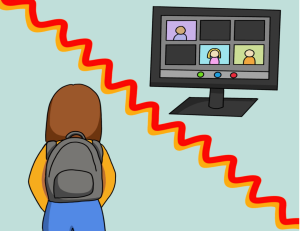Remote learning should be implemented to lower Omicron cases
February 2, 2022
Despite the large influx of COVID-19 cases so far in 2022, little change in school policy has taken place. It is time for the seriousness of this issue to be taken into account and for remote learning to be implemented.
After Algonquin went fully in-person at the end of April 2021, COVID-19 cases remained relatively stable and were quite low as the 2021-2022 school year began. However, with the Omicron variant’s high transmission rate, cases skyrocketed in December and January, giving a significant need for the school to go fully remote indefinitely and let the number of cases calm down.
The hybrid learning model was put in place for the first three terms of the 2020-2021 school year. Then, students were finally able to attend school in-person all five days a week in late April 2021, as case levels remained low and vaccination rates increased. And when the 2021-2022 school year began, cases were once again low for the first couple of months.
However, in early December, the highly contagious Omicron COVID-19 variant arose with the first cases being found in South Africa and Botswana. Once the first case of Omicron was discovered in the United States, it wasn’t long before there was a surge of cases at Algonquin. This spike took place around the time of winter break, but cases are still rapid as we make our way well into January.
As demonstrated in the MetroWest COVID-19 Dashboard, case levels are continuing to go up, and this is true for both the community and the school itself. With the data in mind, it is very clear that going to school five days a week will cause cases to continue to rise. Even though the majority of the student body is fully vaccinated and will likely not see hospitalization if COVID-19 positive , there are many members of the greater school community who aren’t. Many might be immunocompromised and aren’t able to receive the vaccine as a result of age or their ongoing illnesses. Therefore, staying in person will likely cause a big risk for public health.
The high transmission rate of the Omicron variant will further cause these health risks. While going fully remote might seem very nerve-wracking due to some students’ negative experiences with online school, it is the best option to keep the school safe. I believe that if remote learning was implemented, it would look similar to our current in-person model, but it will most likely have a single lunch period, since cafeteria space isn’t needed for students to eat lunch.
The best decision for district administrators would be to keep remote learning in place for two to three weeks while COVID-19 cases settle. Not only would this period of social distancing lower the transmission rate, but it would also give the facilities staff adequate time to sanitize the school. In addition, it would give students time to get their booster vaccine before returning to school, as this shot can require a recovery period for some.
It is time for administrators to start making changes beyond separating desks and limiting group work. The best decision for the district is to go remote for a short period of time in order to lower cases.









